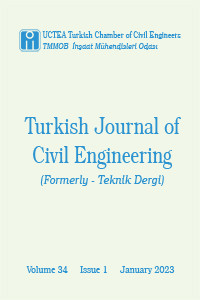Influence of Gravity Framing on the Collapse Probability of Steel Buildings with Special Moment Frames
Steel structures, Gravity Framing, Nonlinear dynamic analysis, Collapse Probability
Influence of Gravity Framing on the Collapse Probability of Steel Buildings with Special Moment Frames
___
- Leon, R., Composite connections, Structural Engineering Handbook, CRC Press LLC, 1999.
- Huang, Z., and Foutch, D.A., Effect of hysteresis type on drift limit for global collapse of moment frame structures under seismic loads, Journal Earthquake Engineering, 13(7), 939-964, 2009.
- Lignos, D., and Krawinkler, H., Sidesway Collapse of Deteriorating Structural systems under Seismic Excitations, Report No. TB 172, John A. Blume Earthquake Engineering Center, Stanford University, CA, 2012.
- Gupta, A., and Krawinkler, H., Behavior of ductile SMRFs at various seismic hazard levels, Journal of Structural Engineering, 126(1), 98–107, 2000.
- Ramos, M.D., Mosqueda, G. and Hashemi, M.J., Large-scale hybrid simulation of a steel moment frame building structure through collapse, Journal of Structural Engineering, 142(1), 04015086, 2016.
- MacRae, G.A., Kimura, Y. and Roeder, C., Effect of column stiffness on braced frame seismic behavior, Journal of Structural Engineering, 130(3), 381-391, 2004.
- Ji, X., Kato, M., Wang, T., Hitaka, T. and Nakashima, M., Effect of gravity columns on mitigation of drift concentration for braced frames, Journal of Constructional Steel Research, 65(12), 2148-2156, 2009.
- Elkady, A. and Lignos, D. G., Effect of gravity framing on the overstrength and collapse capacity of steel frame buildings with perimeter special moment frames, Earthquake Engineering & Structural Dynamics, 44, 1289-1307, 2015.
- Lee, K. and Foutch, D. A., Performance evaluation of new steel frame buildings for seismic loads, Earthquake Engineering and Structural Dynamics, 31, 653-670, 2002.
- Flores, F.X., Charney, F.A. and Lopez-Garcia, D., Influence of the gravity framing system on the collapse performance of special steel moment frames, Journal of Constructional Steel Research, 101, 351-362, 2014.
- Foutch, D. A., and Yun, S., Modeling of steel moment frames for seismic loads, Journal of Constructional Steel Research, 58, 529-564, 2002.
- Astaneh-Asl, A., Modjtahedi, D., McMullin, K., Shen, J. and D’Amore, E., Stability of damaged steel moment frames in Los Angeles, Journal of Constructional Steel Research, 20, 443-446, 1998.
- Sizemore, J., Davaran, A., Fahnestock, L., Tremblay, R. and Hines, E., Seismic behaviour of low-ductility concentrically-braced frames, Structures Congress, ASCE Library, 2014.
- Karasu, A. and Vatansever, C., Experimental Study on the Behavior of Header End - Plate Connections under Cyclic Loading, Technical Journal of Turkish Chamber of civil engineers, 32(6), 2021.
- Turkish Seismic Code for Buildings 2018, Specifications for Design of Buildings under Earthquake Action, Disaster and Emergency Management Presidency, Ankara.
- Chisari, C., Francavilla, A.B., Latour, M., Piluso, V., Amadio, C. and Rizzano, G., Critical issues in parameter calibration of cyclic models for steel members, Engineering Structures, 132, 123-138,2017.
- OpenSees, Version 2.0, User Command-Language Manual, 2009.
- Turkish code for design and construction of steel structures 2016, Ministry of Environment and Urbanisation, Ankara, Turkey.
- Krawinkler, H., The state-of-the-art report on system performance of moment resisting steel frames subjected to earthquake ground shaking, FEMA 355c, Washington, DC: Federal Emergency Management Agency, 2000.
- CSI. SAP2000 v18 integrated finite element analysis and design of structures, Berkeley: Computers and Structures; 2016.
- Ibarra, L.F., Medina, R.A., and Krawinkler, H., Hysteretic models that incorporate strength and stiffness deterioration, Earthquake Engineering Structural Dynamic, 34(12), 1489-1511, 2005.
- Lignos, D. G. and Krawinkler, H., Deterioration Modeling of Steel Components in Support of Collapse Prediction of Steel Moment Frames under Earthquake Loading, Journal of Structural Engineering, 137 (11), 1291-1302, 2011.
- Lignos, D. G., Hartloper, R.H., Elkady, A., Deierlein, G.G. and Hamburger, R., Proposed Updates to the ASCE 41 Nonlinear modeling parameters for wide-flange steel columns in support of performance-based seismic engineering, Journal of Structural Engineering, 145 (9), 04019083, 2019.
- Gupta, A. and Krawinkler, H., Seismic demands for the performance evaluation of steel moment resisting frame structures, Report No. 132, The John A. Blume Earthquake Engineering Center, Stanford University, CA, 1999.
- Lignos, D.G., Putman, C., Krawinkler, H., Seismic assessment of steel moment frames using simplified nonlinear models, Computational Methods in Earthquake Engineering, 30(0), 91–109, 2013.
- FEMA, Quantification of building seismic performance factors, Report FEMA-P695, Federal Emergency Management Agency, Washington, DC, 2009.
- Zareian, F., Medina, R.A., A practical method for proper modeling of structural damping in inelastic plane structural systems, Computers & Structures, 88(1), 45–53, 2010.
- Chopra, A.K., Dynamics of structures theory and applications to earthquake engineering, Fourth edition, Prentice Hall, U.S.A, 2013.
- Lignos, D.G., Putman, C., Krawinkler, H., Application of simplified analysis procedures for performance-based earthquake evaluation of steel special moment frames, Earthquake Spectra, 31(4), 2015.
- ASCE/SEI 7-16, Minimum design loads for buildings and other structures, Reston, VA: ASCE, 2017.
- Vamvatsikos, D., Cornell, C.A., Incremental dynamic analysis, Earthquake Engineering & Structural Dynamics, 31(3), 491–514, 2002.
- ISSN: 2822-6836
- Yayın Aralığı: 6
- Başlangıç: 1990
- Yayıncı: TMMOB İnşaat Mühendisleri Odası
Evaluation of Field Shear Wave Velocity in Deep Soil Mixing Based on Laboratory Studies
Investigations of Exterior Wind Flow and Aerodynamic Coefficient around Y-Plan Shape Tall Building
Determination of Finite Element Modelling Errors for Box Culverts Using Field Load Tests
The Effect of Hydrated Lime Mixing Forms and Ratios on Performance in Asphalt Pavements
Celaleddin Ensar ŞENGÜL, Dündar AYYILDIZ, Erol İSKENDER, Atakan AKSOY
The High Temperature Performance Evaluation of Polymer/Nanocomposite Modified Asphalt Cement
Mustafa ALAS, Ali ALBRKA, Hüseyin GÖKÇEKUŞ
Adem KARASU, Cüneyt VATANSEVER
Evaluation of Stripping Problem in Terms of Additive Types and Ratios in Asphalt Pavements
Celaleddin Ensar ŞENGÜL, Atakan AKSOY, Erol İSKENDER
Effect of Sub-Contractor Selection on Construction Project Success in Turkey
Ali Erkan KARAMAN, Koray SANDAL
Entropy Based Regional Precipitation Prediction in the Case of Gediz River Basin
